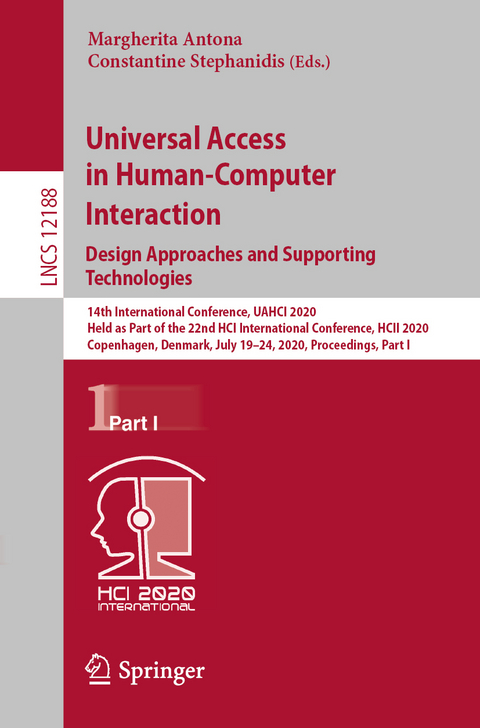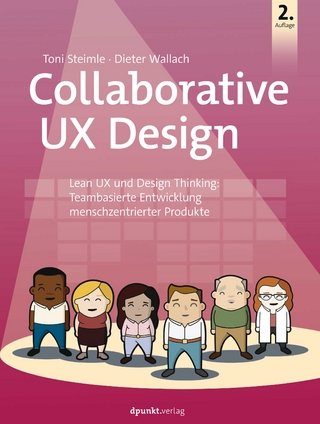
Universal Access in Human-Computer Interaction. Design Approaches and Supporting Technologies
Springer International Publishing (Verlag)
978-3-030-49281-6 (ISBN)
UAHCI 2020 includes a total of 80 regular papers which are organized in topical sections named: Design for All Theory, Methods and Practice; User Interfaces and Interaction Techniques for Universal Access; Web Accessibility; Virtual and Augmented Reality for Universal Access; Robots in Universal Access; Technologies for Autism Spectrum Disorders; Technologies for Deaf Users; Universal Access to Learning and Education; Social Media, Digital Services, eInclusion and Innovation; Intelligent Assistive Environments.
Universal Design of ICT: A Historical Journey from Specialized Adaptations towards Designing for Diversity.- From Accessible Interfaces to Useful and Adapted Interactions.- Integrated Assistive Auxiliary System - Developing Low Cost Assistive Technology to Provide Computational Accessibility for Disabled People.- Co-creating Persona Scenarios with Diverse Users Enriching Inclusive Design.- Construction of an Inexpensive Eye Tracker for Social Inclusion and Education.- Understanding Organizations through Systems Oriented Design: Mapping Critical Intervention Points for Universal Design.- Process Modelling (BPM) in Healthcare - Breast Cancer Screening.- Brain-Computer Interfaces for Communication in Severe Acquired Brain Damage: Challenges and Strategies in Clinical Research and Development.- Evaluating Hands-on and Hands-free Input Methods for a Simple Game.- Affective Communication Enhancement System for Locked-In Syndrome Patients.- Perceived Midpoint of the Forearm.- User Interfacesin Dark Mode During Daytime - Improved Productivity or Just Cool-Looking?.- Usability Evaluation of Short Dwell-time Activated Eye Typing Techniques.- A Comparative Study of Three Sudoku Input Methods for Touch Displays.- QB-Gest: Qwerty Bimanual Gestural Input for Eyes-free Smartphone Text Input.- Exploring WAI-Aria Techniques to Enhance Screen Reader Interaction: The Case of a Portal for Rating Accessibility of Cultural Heritage Sites.- Impact of Sentence length on the Readability of Web for Screen Reader Users.- Towards Universal Accessibility on the Web: Do Grammar Checking Tools Improve Text Readability?.- Investigating the Effect of Adding Visual Content to Textual Search Interfaces on Accessibility of Dyslexic Users.- A Comparative Study of Accessibility and Usability of Norwegian University Websites for Screen Reader Users Based on User Experience and Automated Assessment.- Usability of User-centric Mobile application design from Visually Impaired People's Perspective.- Large Scale Augmented Reality for Collaborative Environments.- Walking Support for Visually Impaired Using AR/MR and Virtual Braille Block.- Effect of Background Element Difference on Regional Cerebral Blood Flow while Viewing Stereoscopic Video Clips.- Dementia: I Am Physically Fading. Can Virtual Reality Help? Physical Training for People with Dementia in Confined Mental Health Units.- A Virtual Rehabilitation System for Occupational Therapy with Hand Motion Capture and Force Feedback -Implementation with Vibration Motor.- iVision: An Assistive System for the Blind based on Augmented Reality and Machine Learning.- Relationship between Eye Movements and Individual Differences in Motion Sickness Susceptibility While Viewing Stereoscopic Movies under Controlled Consciousness.- HoloPrognosis - An AR-based Serious Exercise Game for Early Stage Parkinson's Disease Patients.- A Feasibility Study on the Application of Virtual Reality Technology for the Rehabilitation of Upper Limbs after Stroke.- Usable and Accessible Robot Programming System for People Who are Visually Impaired.- Lego Robots in Puppet Play for Children with Cerebral Palsy.- Being Aware of One's Self in the Auto-Generated Chat with a Communication Robot.- Voice User Interfaces for Service Robots: Design Principles and Methodology.- Robotic Cane for the Visually Impaired.
| Erscheinungsdatum | 29.06.2020 |
|---|---|
| Reihe/Serie | Information Systems and Applications, incl. Internet/Web, and HCI | Lecture Notes in Computer Science |
| Zusatzinfo | XXV, 521 p. 230 illus., 179 illus. in color. |
| Verlagsort | Cham |
| Sprache | englisch |
| Maße | 155 x 235 mm |
| Gewicht | 831 g |
| Themenwelt | Mathematik / Informatik ► Informatik ► Betriebssysteme / Server |
| Informatik ► Software Entwicklung ► User Interfaces (HCI) | |
| Schlagworte | Applications • Artificial Intelligence • Communication Systems • Computer Hardware • Computer Networks • Computer Science • Computer systems • computer vision • conference proceedings • Data communication systems • Engineering • Human-Computer Interaction (HCI) • Informatics • Information Retrieval • Internet • Network Protocols • Research • sensors • Signal Processing • Software engineering • Telecommunication networks • Telecommunication Systems • User Interfaces • user with disabilities |
| ISBN-10 | 3-030-49281-8 / 3030492818 |
| ISBN-13 | 978-3-030-49281-6 / 9783030492816 |
| Zustand | Neuware |
| Haben Sie eine Frage zum Produkt? |
aus dem Bereich


